Acute febrile illness can be caused by diverse pathogens like bacteria, viruses, parasites and fungi. Infectious diseases are one of the leading causes of mortality and morbidity. The aetiological agents causing acute febrile illness vary according to the geographical location. In tropical countries, Dengue and Leptospirosis are emerging public health problems and mixed infections are not uncommon [1]. The incidence of both these infections increases during monsoon and rainy season [2]. Due to simultaneous transmission of both these infections during rainy season, co-infections can occur [3]. Both these infections are characterized by fever with myalgia. These mixed infections can change the clinical spectrum of disease to more fulminant course and presents a diagnostic and therapeutic challenge to the treating physicians [3,4].
It is important to differentiate between Dengue and Leptospirosis in order to start the patients early on antibiotics and such patients show favourable outcome. Dengue and Leptospirosis are often under reported leading to increased mortality during concomitant epidemics. This study aims at determining the prevalence of Dengue and Leptospira co-infections in acute febrile illness patients in a tertiary care hospital by using improved diagnostic techniques in order to prevent life-threatening complications.
Materials and Methods
This cross-sectional study was conducted at Chettinad Hospital and Research Institute, Kelambakkam during the period from July 2016 to June 2017 and blood samples were collected from 100 patients with Acute Febrile Illness (AFI), having fever of 1-7 days duration and having come to the hospital for further management. Based on the prevalence of Dengue and Leptospira co-infection in previous studies [2,11-14] sample size was calculated. The Institutional Human Ethics Committee clearance was obtained prior to commencing this study and the samples were collected after obtaining informed consent from the patient. Ten mL of venous blood was collected by venepuncture from each patient [15] under aseptic conditions and serum was separated by centrifugation. The samples were screened for Dengue infection by performing Dengue NS1 antigen detection, DENV antibodies IgM, IgG detection and Leptospira IgM antibodies by ELISA. Dengue NS1 positive samples were also subjected to Polymerase Chain Reaction (PCR) for rapid diagnosis of dengue and leptospirosis. Haematological and biochemical parameters such as Platelet count, Aspartate transaminase and Alanine transaminase levels were also measured for these patients.
ELISA test was performed for all the 100 separated serum samples for Dengue NS1 antigen detection by using commercially available ELISA kit, Dengue NS1 Antigen Microlisa, (J.Mitra & Co. Pvt., Ltd.,) based on “Direct Sandwich ELISA” [16,17] technique. MAC (IgM Antibody Capture) and GAC (IgG Antibody Capture) ELISA were performed for detection of Anti-dengue IgM and IgG antibodies respectively. Tests were performed as per the kit manufacturer’s instructions.
Dengue ELISA is an in-vitro qualitative test used to detect Dengue NS1 antigen or Anti-dengue IgM and IgG antibodies in a patient sample by a colour reaction developed by the addition of enzyme (horse radish peroxidase) conjugate and substrate.
Dengue NS1 Antigen ELISA kit is based in the Direct Sandwich ELISA principle. Briefly required number of microtiter wells coated with Anti-dengue antibodies were taken, followed by the addition of 50 μL of sample diluent added in all the wells. Then 50 μL of negative control, calibrator and positive control were added in A-1, B-1, C-1, D-1 and E-1 wells respectively. A 100 μL of working conjugate added in each well and then covered and then kept for incubation at 37°C for 90 minutes. Once the incubation time was over, wells were washed six times with washing buffer and then 150 μL of substrate were added and incubated at room temperature in dark for half an hour. Then 100 μL of stop solution was added to stop the reaction and then read by ELISA reader at the wavelength of 450nm. Cut-off value was calculated and results were interpreted as per kit instructions.
Dengue antibody detection was based on MAC/GAC Capture ELISA principle in which the microtitre wells are coated with capture antibodies (anti-human immunoglobulin). A 100 μL of Negative control (A1well), calibrator (B1, C1, D1) and Positive control (E1) were added in their respective wells and 100 μL of diluted sample were added in each well from F1 onwards. This was incubated at 37°C for 1 hour. Following this, the wells were washed with washing buffer and 100 μL of working conjugate were added. Incubated again at 37°C and then washed after the completion of incubation. A 100 μL of chromogen substrate was added and incubated at room temperature in dark for 30 minutes. Then 50 μL of stop solution were added to stop the reaction and then the absorbance was read at 450nm in ELISA reader. Calculation was done and results were interpreted as per kit instructions.
Dengue NS1 positive samples were subjected to Dengue Real-time PCR for detection of viral RNA by using Helini Dengue Universal Real-time PCR kit {Helini Biomolecules, Chennai, TamilNadu}. PCR amplification was preceded with viral RNA purification. The steps of Dengue RT PCR include reverse transcription at 420C for 30 minutes followed by Taq enzyme activation at 950C for 15 minutes. This was followed by 45 cycles of denaturation at 950C for 20 seconds, Primer Annealing at 560C for 20 seconds and primer extension at 720C for 20 seconds. Total reaction volume used in this procedure was 25 μL.
Primer sequence used for Dengue detection was [18]:
Forward primer: 5’-GARAGACCAGAGATCCTGCTGTCT-3’
Reverse primer: 5’-ACCATTCCATTTTCTGGCGTT-3’
TaqMan MGB probe 5’-AGCATCATTCCAGGCAC -3’
Leptospira IgM ELISA is a screening procedure used for the diagnosis of acute Leptospira infection in which IgM antibodies against genus specific Leptospira antigen were detected. Microtiter wells were coated with Leptospira antigen which bound to the IgM antibodies specific for Leptospiral antigen present in the patient’s serum. This was washed six times to remove the unbound antibody and horse radish peroxidase conjugated antibody added. Microtiter wells were washed once again followed by the addition of substrate chromogen tetra-methyl benzidine/hydrogen peroxide (TMB chromogen) which on reaction with the enzyme produces blue colour. Stop solution (1N Sulphuric acid) was added to stop the enzyme-substrate reaction and becomes yellow. Intensity of the colour developed was proportional to the amount of IgM antibodies present in the test sample.
Detection of Leptospiral DNA by Polymerase Chain Reaction: Polymerase chain reaction is a rapid, highly sensitive and specific assay for detection of Leptospiral DNA. Bacterial DNA was extracted before subjecting it to PCR amplification. DNA extraction was done using the commercial kit {Nucleospin®, Tamil Nadu}. PCR amplification was done as per the protocol.
PCR Master Mix- (2X)
Master Mix contained 2U of Taq DNA Polymerase, Taq reaction buffer 10 X, 2 mM MgCl2, 1 μL of 10 mM dNTPs mix and other PCR additives.
The primers Gl (5’ CTG AAT CGC TGT ATA AAA GT) and G2 (5’ GGA AAA CAA ATG GTC GGA AG) were derived from the 5’ end (nucleotides 1-20) and the 3’ end (nucleotides 264-285) of the sequence of the recombinant plasmid pLIPs60. This recombinant plasmid had been selected from the genomic library of Leptospira interrogans [19]. The expected product size was 285 bp. PCR amplification included an initial denaturation, followed by 35 cycle of denaturation at 94°C for 1 minute followed by annealing at 58°C for 1 minute and extension at 72°C for 1 minute. A final extension at 72°C for 2 minutes was also carried out. Agarose Gel Electrophoresis was performed using the kit from Helini Biomolecules which contained agarose, 50X TAE buffer, 6X gel loading buffer and Ethidium bromide.
Statistical Analysis
In this study, Statistical analysis was performed using SPSS software version 24. Multiple comparisons were done between different variables by using Pearson Chi-Square test, One-way ANOVA and Independent sample t-test. Level of significance considered for this study was p<0.05.
Results
Among the 100 patient samples tested, 70 samples were from male patients (30%) and 30 samples were from female patients (30%). The maximum number of patients belonged to the age group of 21 to 30 years, followed by 11 to 20 years [Table/Fig-1]. The age group containing the maximum number of patients affected by dengue and leptospirosis was between 21-30 years i.e., 14 patients (48.3%) and 9 patients (50%) respectively [Table/Fig-2].
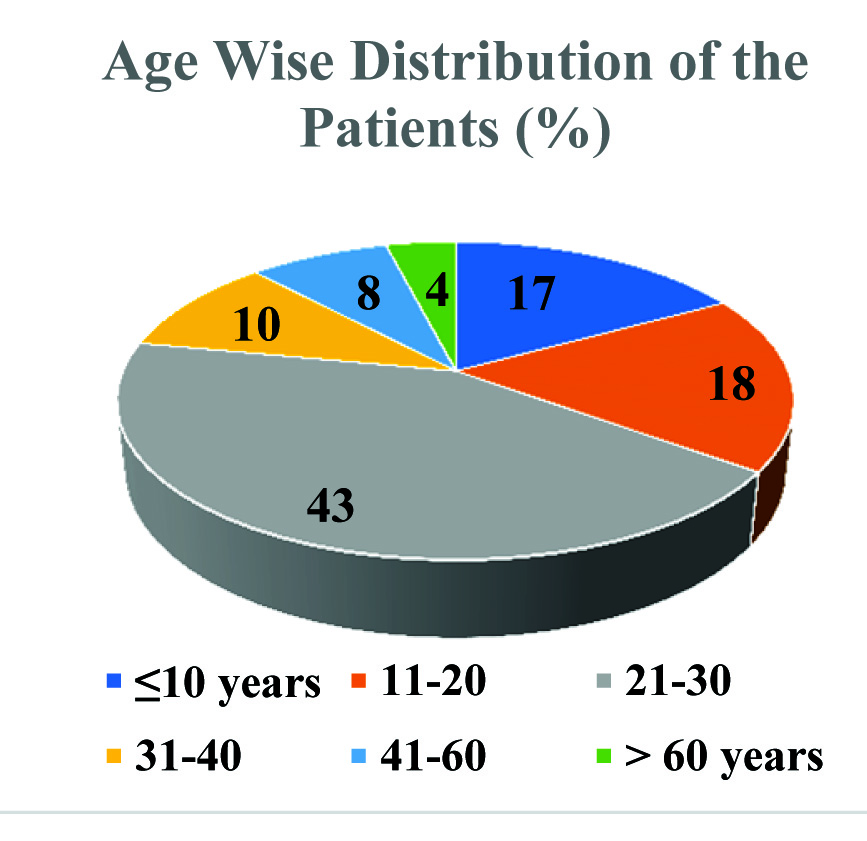
Age-wise distribution of dengue and leptospirosis positive cases.
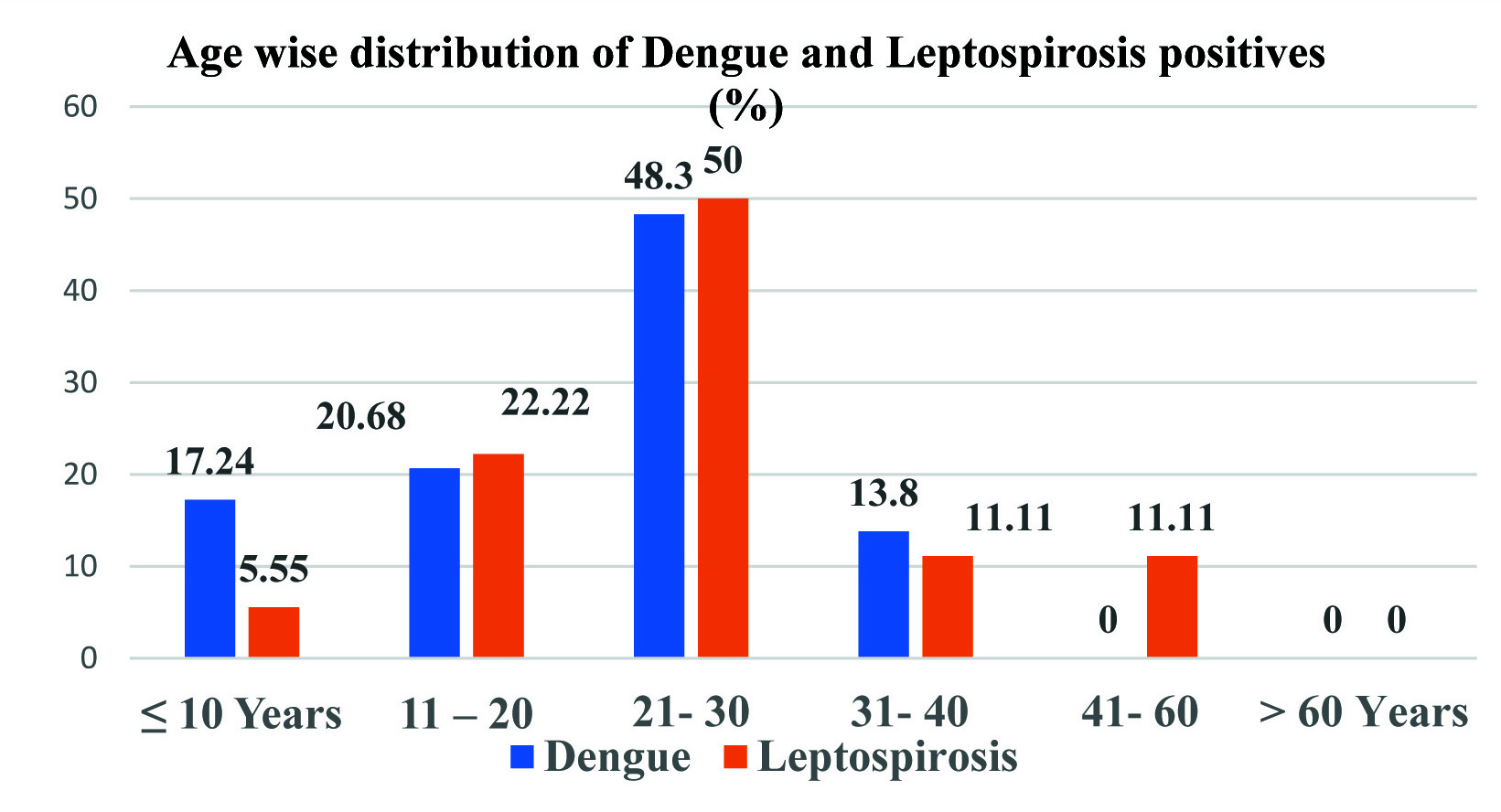
Dengue infection was positive in 29 patients (29%) and Leptospirosis was positive in 18 patients (18%). The number of Dengue positive cases among the males was 21(72.5%) and in females were 8(27.5%). The number of Leptospirosis positive cases among the males was 13(72.2%) and in females were 5(27.7%). In this present study, the rates of infection for both Dengue and Leptospirosis were found to be slightly higher among the males as compared to females. In the remaining patients, febrile illnesses may have been due to other aetiologic agents. Dengue and Leptospira co-infection was positive in 4 patients (4%) which were detected by ELISA and PCR. Of the 4 patients with co-infection, 3 (75%) were males and 1 (25%) was female.
Among the dengue positive patients, NS1 antigen was positive in 22 out of 29 cases (75.86%), anti-dengue IgM was positive in 15 out of the 29 cases (51.72%) and anti-dengue IgG was positive in 8 out of 29 cases (27.58%). All the 3 tests, Dengue NS1, IgM and IgG antibodies were positive in 3 (10.34%) out of 29 Dengue positives cases. All the 4 tests i.e., Dengue NS1, RT PCR, Anti Dengue IgM and IgG antibodies were positive in 2 out of 29 samples (6.89%) [Table/Fig-3].
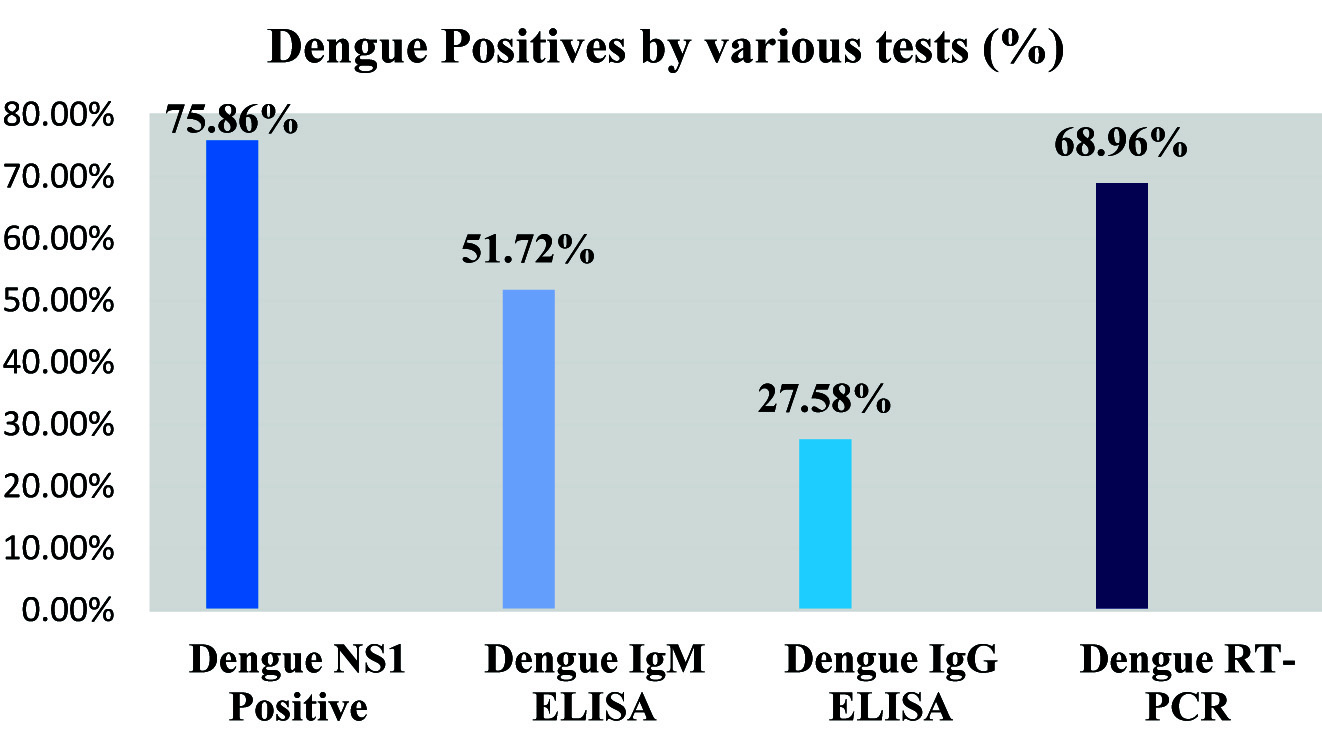
Among the 22 dengue positive patients by Dengue NS1 ELISA and real time RT-PCR (22/100) test, 68.96% were found to be positive by RT-PCR and 75.86% by Dengue NS1 antigen ELISA. Dengue RT-PCR was found to be positive in 20 (68.96%) out of the 22 NS1 positive samples and it was not positive in any of the NS1 Antigen negative samples. Among the 18 Leptospira positive patients, Leptospira IgM was positive in 8 patients (44.44%) and Leptospira PCR was positive in 10 patients (55.55%) [Table/Fig-4].
Distribution of Leptospira positive cases.
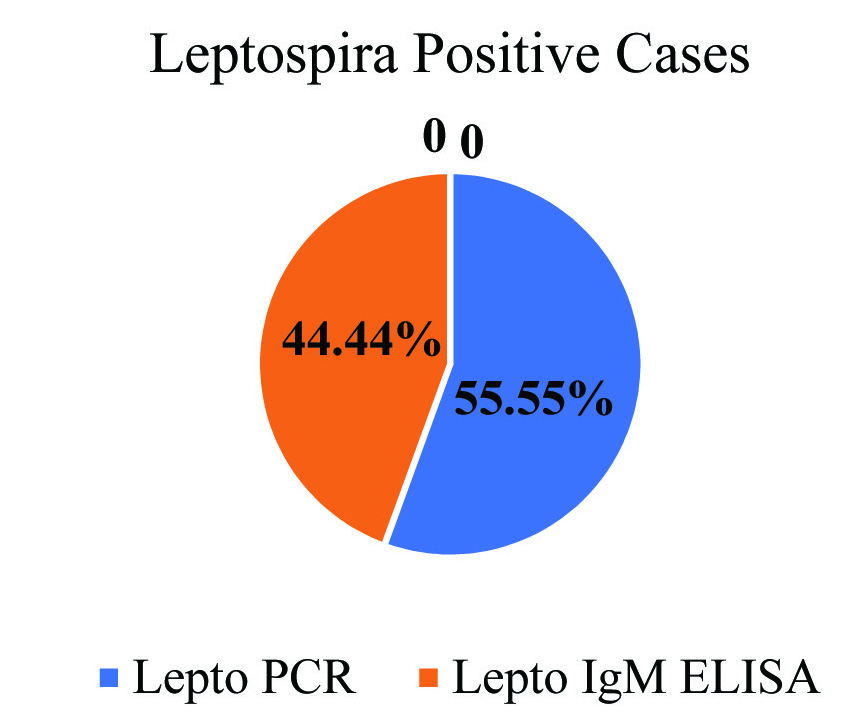
Among the four patients with Dengue and Leptospira co-infection, three (75%) were found to be positive for Dengue NS1, RT-PCR [Table/Fig-5] and Leptospira PCR [Table/Fig-6] and the other one (25%) was found to be positive for anti- dengue IgM and Leptospira IgM antibodies.
Amplification plot-dengue real-time PCR.
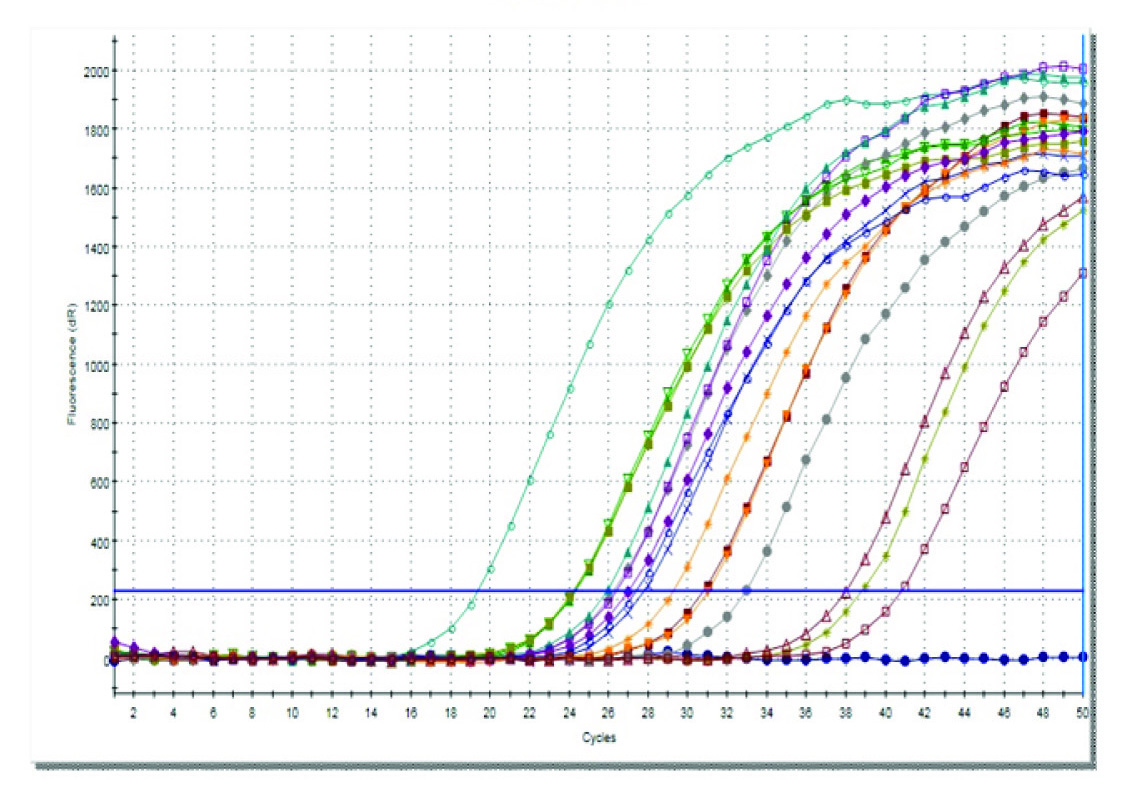
Gel documentation for PCR for leptospirosis.
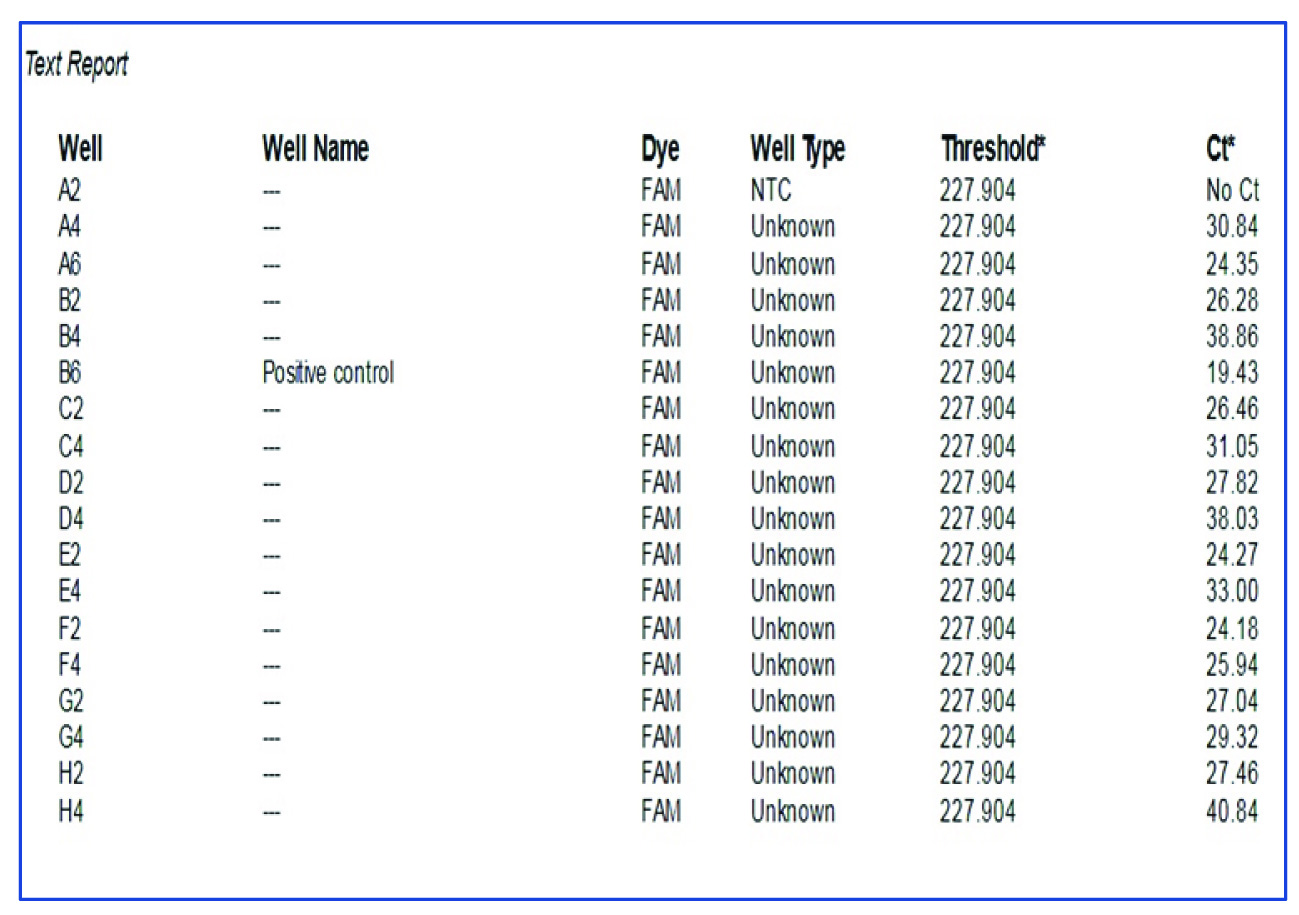
The co-infected patients who were positive for Dengue NS1 and Leptospira PCR showed mild elevation of Alanine transaminase and Aspartate transaminase. They also had thrombocytopenia which was found to statistically significant by Pearson chi square test (p<0.001) [Table/Fig-7]. In addition, the single patient who was positive for both anti-dengue IgM antibodies and Leptospira IgM antibodies showed significant decrease in platelet count which was statistically significant (p<0.001).
Statistical analysis of the results by Pearson Chi-square test.
| Parameters | Pearson Chi-square test |
|---|
| Dengue Ns1 Positives & decreased Platelet count. | p<0.001 |
| Dengue Real time RT-PCR positives and decreased Platelet count. | p=0.001 |
| Dengue NS1, RT-PCR positives & decreased platelet count. | p=0.001 |
| Dengue NS1, Leptospira PCR positives & significant decrease in platelet count | p=0.000 |
| Dengue NS1 positives & Gender | p=0.199 |
| Dengue NS1 positives & Gender | p=0.199 |
| Dengue IgM positives & Gender | p=0.766 |
| Dengue IgG positives & Gender | p=1.000 |
| Dengue RT-PCR positives & Gender | p=0.171 |
| Leptospira IgM ELISA positive & Gender | p=0.786 |
| Leptospira PCR positive & Gender | p=0.236 |
Discussion
Dengue and Leptospirosis are the most common emerging infections throughout the world. These infections are one of the most common causes of Acute Febrile Illness in tropical regions. Most of the signsand symptoms of Leptospirosis are similar to that of dengue and are often confused and thus leptospirosis cases are undiagnosed. Several studies have showed that these dual infections are under-reported [20-22].
A previous study by Brown et al., has showed 2.5% of Dengue IgM positive cases were also found to be positive for Leptospirosis by ELISA IgM [22]. In this study, Leptospirosis and Dengue co-infection were observed in four patients and out of that, three were positive for Dengue NS1, Dengue RT-PCR and Leptospira PCR and one was found to be positive for anti-dengue IgM antibodies and Leptospira IgM antibodies.
An earlier study which was conducted in semi-urban region of Kerala had showed that Leptospirosis accounted for 16% and Dengue for 15% with co-infection rate of 1.4% [2]. But, in this study, Dengue infection was found in 29% of patients and Leptospirosis was found in 18% of patients and the co-infection were found to be 4% which was found to be little higher than the previous study since highly sensitive and specific molecular diagnostic method was used in addition to ELISA method for detection.
Among the 22 (22%) Dengue positive patients by Dengue NS1 ELISA and real time RT-PCR (22/100) test, 68.96% were found to be positive by RT-PCR and 75.86% by Dengue NS1 antigen ELISA. This means that the positivity rate of Dengue infection by NS1 antigen ELISA was little higher than the Dengue RT-PCR which was also shown in another study by Kumar et al., in South India [2] where the highest detection rate (80.9%) was by NS1 antigen ELISA and only 68.1% was detected by conventional RT-PCR. In this study, 68.96% of positive cases were detected by real time RT-PCR which was lesser than the NS1 ELISA (75.86%).
In the present study, Real time Dengue PCR was performed by using universal primers which are highly conserved in all dengue serotypes targeting 3’UTR (untranslated region) sequence and this is group specific. This group specific PCR is useful in initial screening of DENV in endemic areas. Both NS1 antigen ELISA and RT-PCR are useful in early diagnosis of dengue infection. NS1 antigen persists in the serum from day 1 to day 9 [23] whereas viremia decreases by 4th-5th day [24,25]. Therefore, RT-PCR detects viral RNA till 5th day of fever. Here, in this study, we have screened the acute febrile illness patients of 1-7 days duration. Thus, this could be the probable reason for higher detection rate by NS1 antigen ELISA than that of RT-PCR. However, both the methods are rapid and can diagnose the illness within three days of fever [26]. In this study, the detection rate of primary dengue infection increased to 96.5% by combining the NS1 antigen ELISA with that of anti-dengue IgM ELISA and the detection rate is much higher than the either test alone. Also, the detection rate increased to 89.65% by combining RT-PCR and IgM ELISA. Hence, all these three assays are helpful in early diagnosis of acute dengue infection. However, the sensitivity is much higher in combination tests [2] than the either test alone.
Among the Leptospirosis patients, 55.55% were detected by conventional PCR and 44.44% were detected by Leptospira IgM ELISA. PCR was done to detect the Leptospiral DNA in this study which picked up 55.55% (10 out of 18) of Leptospirosis cases in acute phase of fever whereas antibodies against Leptospires were detected by Leptospira IgM ELISA and the detection rate was (44.44%) (8 out of 18) in acute phase of fever. Studies have showed the sensitivity of PCR for Leptospiral DNA detection was around 52% and that of Leptospira IgM ELISA was 59% [27]. None of the cases were found to be positive by both Leptospira PCR and IgM ELISA.
Previous studies have stated that detection rate of Leptospiral infection has been increased by PCR method rather than the rapid serological methods like Leptospira IgM ELISA. Because the serological tests have low sensitivity in acute phase of the disease since the IgM antibodies wouldn’t have formed until 5 -7 days of fever [27,28].
Leptospirosis detection in early phase of the disease was higher by Polymerase Chain Reaction than IgM ELISA and PCR detected cases that tested negative by Leptospira IgM antibodies and so this test should be performed for suspected cases on a routine basis for rapid diagnosis of Leptospirosis and to increase case finding [27,28]. PCR detects more positive cases in the acute phase of the disease and therefore serves as an important diagnostic tool in early diagnosis in order to initiate on appropriate anti-microbial therapy and to prevent complications.
All the co-infected patients showed significant decrease in platelet count and elevated liver transaminases (between 50 to 200 U/l) in this study and this may complicate the clinical condition leading to increased mortality. Another study by Kumar A et al., in South India has stated thrombocytopenia in 64.7% and mild elevation of transaminases in 94.11% of co-infected cases [2]. However, the enhanced ability to differentiate this dual infection using rapid and effective diagnostic methods and to start the patients on antibiotics in case of leptospiral infection will prevent devastating complications like acute renal failure, liver failure etc., [29]; and thereby reduce highest mortality and morbidity. Statistical analysis was done to determine the correlation between Dengue and Leptospirosis positive samples and thrombocytopenia by Pearson Chi square test and it was found to be statistically significant with p<0.005 [Table/Fig-7].
Most of the co-infected patients if not diagnosed and treated early show deranged liver and renal function which indicates bad prognosis [2]. But in this study, in spite of thrombocytopenia (<1,00,000/cu.mm) and mildly elevated transaminases, the patients with co-infection did not develop any complications like renal failure, liver failure etc., because of early and rapid diagnosis with robust diagnostic methods and initiation of antibiotics and supportive treatment in the hospital.
Limitation
In this study, dengue serotyping was not done to detect the co-circulation of all four serotypes. To know the shifting trend in the epidemiology of dengue virus and its concurrent infection with multiple serotypes, robust molecular techniques like RT-PCR serotyping and sequencing can be done in future. This will be useful for epidemiological purpose to initiate preventive measures like vector control to decrease the prevalence in India.
Conclusion
Dengue and Leptospira co-infections are common in endemic areas and may result in overlapping signs and symptoms, making the case management difficult. Leptospirosis has definite antibiotic treatment unlike dengue infection and should be ruled out in endemic areas. This study stresses upon the need for increased awareness of co-infections and the importance of using a combination of tests to diagnose dengue and leptospirosis, for the early management and to prevent complications.